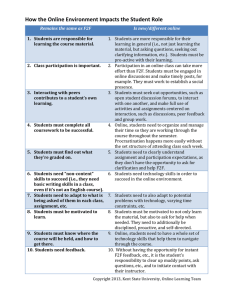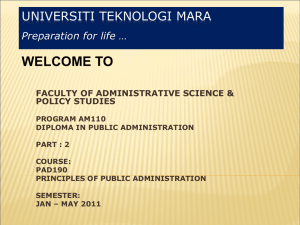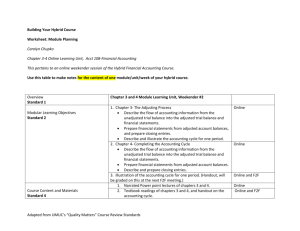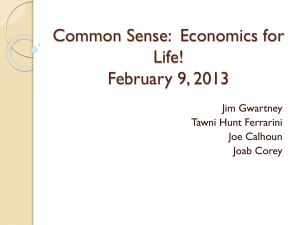B K l K*
advertisement
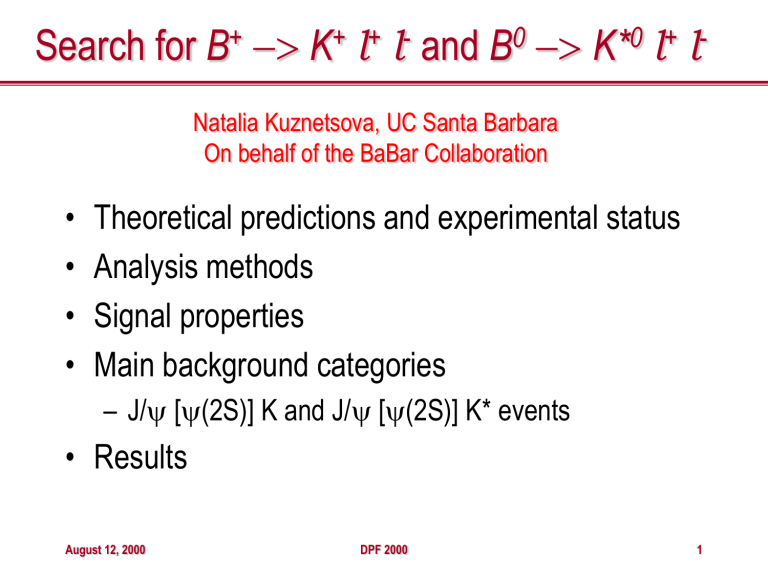
Search for B+ -> K+ l+ l- and B0 -> K*0 l+ lNatalia Kuznetsova, UC Santa Barbara On behalf of the BaBar Collaboration • • • • Theoretical predictions and experimental status Analysis methods Signal properties Main background categories – J/y [y(2S)] K and J/y [y(2S)] K* events • Results August 12, 2000 DPF 2000 1 Theoretical issues l+ b t s W Mode B + -> K+ l+lB 0 -> K *0 e+e- (K *0 -> K+p-) B 0 -> K *0 m+m- (K *0 -> K+p-) b t W Predicted Br. Fr.* (~35% uncertainty) 5.7 x 10 -7 2.3 x 10 -6 1.9 x 10 -6 b W t l- n W s Product Br. Fr. # produced events / 10 fb-1 5.7 x 10 -7 1.5 x 10 -6 1.3 x 10 -6 12.0 16.1 13.3 41.4 TOTAL events produced For now, we are only looking at 3.15 fb-1 of data • this is the first stage of a blind analysis • we expect to have 20 fb-1 by the end of the year *A.Ali et al., Phys. Rev. D. 61, (2000), 074024 (form factors from Light Cone QCD Sum Rules). August 12, 2000 DPF 2000 2 Experimental status 90% CL limits from CLEO (3.33 x 106 BB data set) and CDF (88 pb-1): Mode K+m+mK0m+mK*+m+mK*0m+mK+e+eK0e+eK*+e+eK*0e+e- CLEO* CDF** < 9.7 x 10 -6 < 5.2 x 10 -6 < 31.0 x 10 -6 < 33.0 x 10 -6 < 9.5 x 10 -6 < 4.0 x 10 -6 < 11.0 x 10 -6 < 17.0 x 10 -6 < 38.0 x 10 -6 < 14.0 x 10 -6 *CLEO CONF 98-22, ICHEP98 1012 (1998) (unpublished). **T. Affolder et al., Phys. Rev. Lett. 83, (1999), 3378. August 12, 2000 DPF 2000 3 Analysis Methods (1) • Basic ideas: – Perform a blind analysis – Select charged particle modes only: • B+ -> K+e+e-, B+ -> K+m+m-, B0 -> K*0e+e-, B0 -> K*0m+m- (where K*0 -> K+p-) – use DE vs. mES plane to select signal region MC truth tagged signal B+ -> K+e+e- mES ( s / 2)2 - ( pB *)2 DE EB * - s / 2 MES (GeV/c2) • EB*(pB*) is the B candidate energy (momentum) in the CM frame • August 12, 2000 s = center-of-mass energyd nal events lie outside the signal box (signal MC) DPF 2000 4 Analysis Methods (2) • • • • • Select electrons with pLABe > 0.5 GeV/c and muons with pLABm > 1.0 GeV/c Require high multiplicity events (with # of tracks > 4); veto g conversions Veto J/y, y(2S) resonance regions Suppress continuum background using Fisher discriminant Particle ID: • electron ID based on energy deposition in the CsI calorimeter • muon ID based on the penetration length in the Instrumented Flux Return • hadron ID based on combined drift chamber dE/dx and Cherenkov angle information Mode K+e+e- K+m+m- Efficiency, % 13.1 8.6 August 12, 2000 DPF 2000 K*0e+e- K*0m+m- 7.7 4.5 5 Predicted distributions for q2 = M2l+lB -> K m+m- : B -> K*0 m+m- (pole at q2 = 0): • Solid line + blue bands: SM range ( 35%); Ali et al. form factors • Dotted line: SUGRA model (R7 = -1.2, R9 = 1.03, R10 = 1) • Long-short dashed line: SUSY model (R7 = -0.83, R9 = 0.92, R10 = 1.61) August 12, 2000 DPF 2000 6 Generated distributions for q2 = M2l+lWe have implemented event generators using the model of Ali et al. B -> K m+m- : B -> K*0 m+m- (pole at q2 = 0): generated reconstructed August 12, 2000 DPF 2000 7 Background categories B -> J/y K(K *), y(2S) K(K *) is the most serious background – this background can be controlled by a cut in DE vs. ml+l- plane – also possible to have J/y (-> m + m -) K with K and m swapped – re-assign particle masses and cut on the J/y mass B + -> D 0 (-> K+ p -) p + with p - misidentified as m - and K + as m + – re-assign particle masses and veto the D0 Continuum (e +e - -> qq) – suppressed by using a 4-variable Fisher discriminant Combinatorial from B B events – suppressed by using vertexing August 12, 2000 DPF 2000 8 B -> J/y [y(2S)] K(*) events (1) Signal B -> J/y K and B ->y(2S) K Monte Carlo The most serious background for J/y [y(2S)] -> e+ethis analysis, J/y [y(2S)] K(*) J/y y(2S) events, is suppressed by using a correlated selection in the DE vs. ml+l- plane signal region This is needed to account for bremsstrahlung and track mismeasurement Me+e- (GeV/c2) August 12, 2000 DPF 2000 9 B -> J/y [y(2S)] K(*) events (2) B -> J/y [y(2S)] K(*) control sample (8 fb-1 of data) J/y(->e+e-) K J/y(->m+m-) K MES (GeV/c2) MES (GeV/c2) J/y(-> e+e-) K* MES (GeV/c2) August 12, 2000 J/y [y(2S)] K(*) events are also used as a control sample to verify the analysis efficiency J/y(->m+m-) K* MES (GeV/c2) DPF 2000 10 Results (1) B+ -> K+e+e- B+ -> K+m+m- MES (GeV/c2) MES (GeV/c2) B0 -> K*0 e+e- B0 -> K*0 m+m- MES (GeV/c2) MES (GeV/c2) For the purpose of setting the limit, we assume that all events in the signal region could be due to signal processes Background is not subtracted August 12, 2000 DPF 2000 11 Results (2) Mode # obs. evts # bkg. evts K+ e+eK+ m+mK*0 e+e- 2 0 1 0.20 0.25 0.50 K*0 m+mTotal 0 0.33 3 1.3 Preliminary 90% C.L. limit < 12.5 x 10 -6 < 8.3 x 10 -6 < 24.1 x 10 -6 < 24.5 x 10 -6 The number of background events is extracted from sideband in data Expect 1 signal event based on Geant MC (Ali et al. predictions). August 12, 2000 DPF 2000 12 A candidate B+ -> K+ e+ e- event e+ e- K+ August 12, 2000 DPF 2000 13 Summary • We have searched for the rare decays B+ -> K+ l+ l- and B0 -> K*0 l+ l- using a sample of 3.67 x 106 B B events – We are using this sample to better understand our backgrounds • We have found 3 candidate events total and set preliminary 90% C.L. limits – The limits for the B -> K l+ l- modes are comparable to those set by other experiments – The limits for the B -> K*0 l+ l- modes are less sensitive with this data sample • We are planning to analyze substantially more data in the near future – BaBar will have 20 fb-1 by the end of the year and an extra 30 fb-1 by next year August 12, 2000 DPF 2000 14
